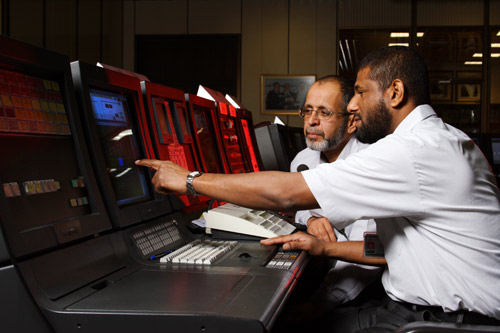GPIC’s Social and Economic Role in Development of Bahrain and Bahrainis
Bahrain Sector Analysis
Gulf Petrochemical Industries Company (GPIC) Social and Economic Role in Development of Bahrain and Bahrainis
GPIC produced 1.47mn tons of fertilizers in 2010, of which 1.1mn tons were exported, contributing 3% to Bahrain’s GDP. GPIC has 474 employees, of which 82% is Bahraini.

Gulf Petrochemical Industries Company (GPIC) Social and Economic Role in Development of Bahrain and Bahrainis
“One Team”
According to the Bahrain National Gas and Oil Authority (NGOA), one of the most distinguishing aspects of GPIC is its “one team” approach to management and employee input. Whilst the executive management finally decides on the vision, goals, objectives and policies of the company, all of these elements are discussed with employees at every level, with the input of each employee expected and respected. As a result, “The one team spirit is propagated throughout the organization on a daily basis through coordination meetings, social activities inside and outside the complex and special functions.”
This concern with employee involvement is most spectacularly demonstrated by GPIC’s multiple programs of employee education and development. One of the reasons for these programs is the company’s commitment to Bahrainization, or hiring indigenous employees. According to the Bahrain NGOA,
“The percentage of Bahrainis in the company is currently in excess of 82% and this percentage is rising annually. Since inception a considerable number of Bahraini personnel have been trained to take up permanent senior positions in the company’s organization.”
GPIC maintains a training center that has state-of-the-art education and training facilities, including is a top class theatre hall, a central library, plant models, training simulators, audio visual centre, class rooms and the E-learning centre which is the first of its kind in the entire Arabian Gulf region.
In 2008 GPIC was honored the First Place for “The outstanding Companies in Training and Human Resources Development – 2008 Awards” by the Ministry of Labor; and in 2009, the Middle East “Best Learner Adoption Statistics” Award in the category of Biggest Usage Statistics by a Company for e-Learning Solution Users from CAFE-ME.
Academy of Leadership and Learning
In 2010, GPIC renamed its training and Development Center as its Academy of Leadership and Learning (ALL), to reflect the company’s commitment not only to its employees but also to the wider community. According to Jawahery,
“Annually we train hundreds of students from schools and universities either during the academic year as part of the student’s graduation requirements or during the summer holidays…. Our much acclaimed Environmental Research and Environmental Lecturing programmes for secondary school students have been running for years now and benefited thousands of students. We believe our role and commitment to train Bahraini nationals in general is equal if not more to that of our employees.”
GPIC’s Economic Role
GPIC produced 1.47mn tons of fertilizers in 2010, of which 1.1mn tons were exported, contributing 3% to Bahrain’s GDP. GPIC has 474 employees, of which 82% is Bahraini.
GPIC produced 1.47mn tons of fertilizers in 2010, of which 1.1mn tons were exported, contributing 3% to Bahrain’s GDP. GPIC has 474 employees, of which 82% is Bahraini.
PIC fosters small and medium enterprises (SMEs) and light industries in the fields of chemicals, detergents, paints, medical and industrial gases, plastics, synthetic sponges, fiberglass, heat insulators and heat insulation slabs.
GPIC believes in equal employment for men and women, which is seen in the rising numbers of women employees on the rolls each year.
Outlook and Plans for the Future
The outlook for the fertilizer industry over the next decade will be tremendous, for three reasons. According to Jawahery:
“The first reason concerns the recent adoption of organic fertilizers, which the recent E. coli outbreak in Europe has shown to be ill-advised. Mineral fertilizer, unlike the organic variety, is 100% germ-free and disease-free. It is extremely safe. There will likely be a shift back toward industrial fertilizers like urea and NPK, which will propel growth.
Second, population growth will drive the growth of the industry because “Global population growth is dependent on the fertilizer industry and on the efficient use and development of fertilizer.”
The International Fertilizer Association, says Jawahery, has been working to bring producers, marketers and consumers together in an effort to improve efficiency. Thus, GPIC has, thanks to this association,
“been able to improve the efficiency of farming significantly over the past 20 years. In the same hectare, you can now produce 3 to 4 times more food than was previously produced. So, although the total land area available for farming is shrinking, the efficiency of that land has improved thanks to the fertilizer industry.”
GPIC has ambitious expansion plans to take advantage of this growth. The board of directors has approved plans for the creation of a massive ammonia and urea project that will increase production from 1.5mn to over 4mn tons annually.
The initiation of this project depends on obtaining additional natural gas. However, major natural gas explorations are taking place, and the government of Bahrain has already agreed to give priority to GPIC when new gas sources are put into production.